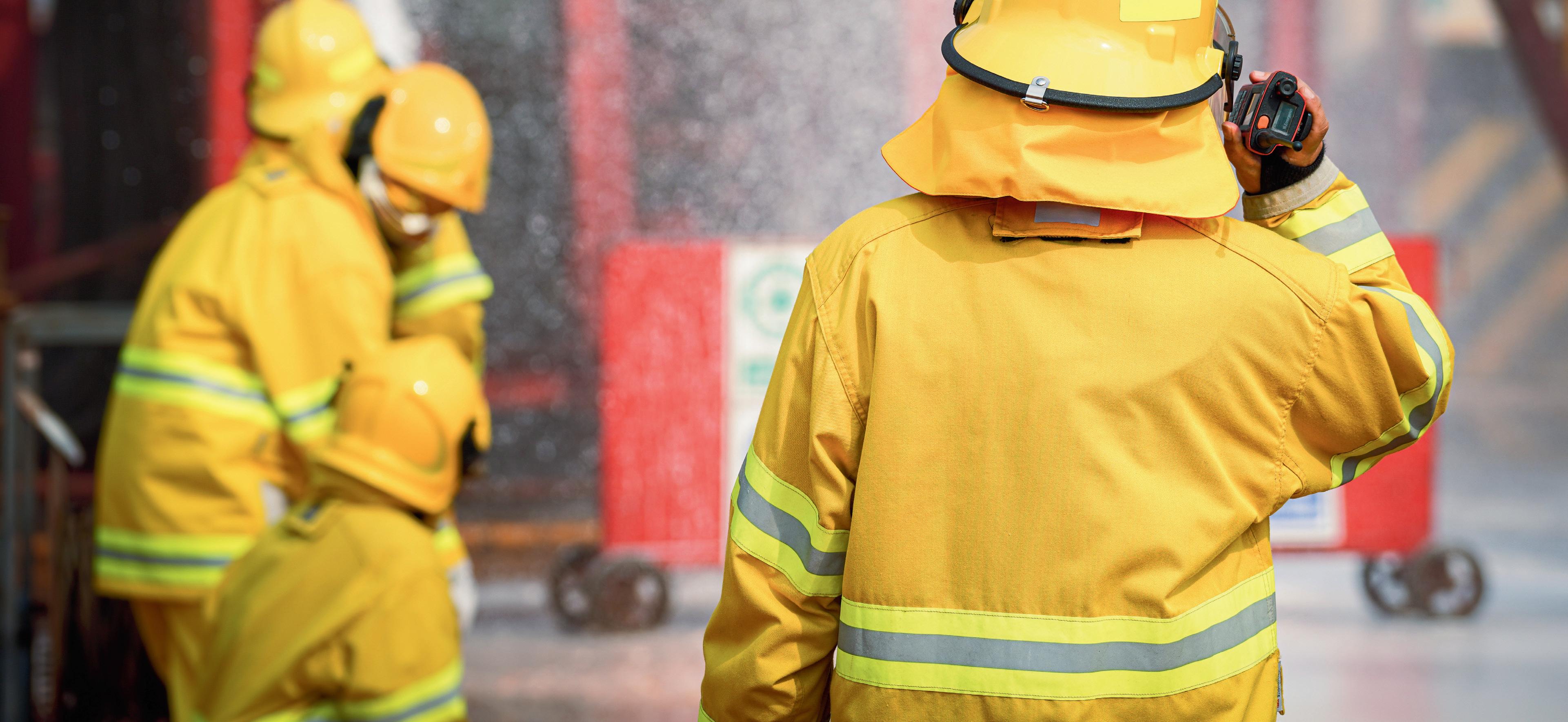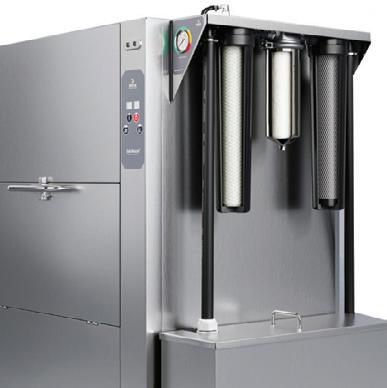
11 minute read
Return to work — support your people with a robust system
RETURN TO WORK
SUPPORT YOUR PEOPLE WITH A ROBUST SYSTEM
Matt Browne, Co-Founder, Donesafe
©stock.adobe.com/au/eakgrungenerd With more Australians returning to work as we reach milestone vaccination rates, the onus is on employers to prioritise workplace safety when it comes to the risk of the pandemic. Integrating technology and automation into your safety management procedures can not only streamline essential compliance requirements, but also helps your employees feel more confident and supported as they return to work.
The global pandemic threw us many curveballs, with different industries being affected in vastly different ways. This is still the case as we return to work in Sydney and Melbourne, with constant shifts in government regulations and restrictions making compliance requirements difficult to manage. But there are ways to make it easier, and ensure your business remains compliant, mitigate risk and support the health and wellbeing of your employees. With all the uncertainty that surrounded the lockdown periods, it’s important to help your workers feel safe and confident about coming back. With reliable, robust and effective safety management procedures in place, you can limit productivity drain and also increase the wellbeing of your teams.
The pandemic caused every business to review and adapt safety management procedures, but with return-to-work regulations around the virus varying across industries and states it can feel complex. For example, vaccination mandates imposed on health care in New South Wales mean workers have until 30 November to be fully vaccinated to continue working. It is an employer’s responsibility to take reasonable steps to ensure workers comply with these orders, and this all has to be recorded for compliance. Employers also face privacy obligations when collecting vaccination details, making it more challenging to monitor vaccination status. With this information falling under the Australian Privacy Act, employers need to ensure that only personal information which is reasonably necessary to prevent or manage the virus in the workplace is collected, used or disclosed.
This is just one scenario where a centralised environmental health and safety (EHS) software system can make a real difference. I am a big believer in technology and its ability to streamline operations, especially when it comes to workplace health, safety and compliance. Advanced systems have the appropriate privacy measures in place, so the data you need is collected and you have appropriate visibility over the vaccination status of your workforce. Once an employee’s vaccination status is recorded and compliance requirements are met, identifying data (like vaccination certificates) are removed from the system. This gives people assurance their details are secure.
An easy-to-use app allows employees to enter their own details, with automated reminders and prompts saving time and taking the pressure off administration staff to physically collect and record data. By centralising this information, you’re taking the necessary steps to remain compliant, while giving your employees the support they need when they’re feeling extra pressure amid constant change. The capabilities of an EHS software extend well beyond vaccination status records of course. And they can be customised to suit your specific industry and business needs, as those requirements change.
Whether or not industry vaccination mandates are in place, employers still have a responsibility to follow virus-safe work procedures to give their teams confidence they are safe at work — and protect their wellbeing, both physically and mentally. It’s important to reduce the risk of employees being exposed to the virus, and also reduce anxiety about returning to work. The right policies, procedures and systems can streamline this part of your operations, make sure you are compliant with a simple audit trail, give you visibility and control, and provide your people with peace of mind. Because they know you care about their health and safety.
COMMUNICATION IS CRUCIAL IN CRITICAL EVENT MANAGEMENT

Every organisation faces risks that can impact its people and assets. If a risk becomes a critical event, organisations must ensure they have processes in place to minimise the fallout and to quickly remediate and recover.
Critical Event Management (CEM) is detecting an event, acting on it to reduce negative outcomes and, importantly, learning from what happened so you can improve your response for future events. This requires a holistic approach that involves all stakeholders, ensuring they receive the right information at the right time.
If we consider a bushfi re, as soon as the fi re is reported, fi refi ghting teams need to be mobilised and people who are at risk need to be notifi ed. If the fi re occurs in a national park, this might mean informing residents in adjacent properties and visitors to the park. When the communications are executed, the response can save lives, wildlife, livestock, and livelihoods.
In the aftermath of the 9-11 attacks in the United States of America, the founders of Everbridge recognised there was a clear need for an integrated CEM platform that went further than messaging. The company has, over the last two decades, built a comprehensive platform that enables governments, their agencies, and emergency services organisations, as well as private businesses, to streamline their response to critical events by supporting the rapid deployment of emergency teams as well as swiftly notifying members of the public if they are at risk.
Everbridge works with governments, emergency management and public and private organisations in more than 200 countries with its comprehensive CEM platform reaching over two billion people. In September 2021, the Australian Government announced that it would be using Everbridge in its response capability, as part of its EAP4 system in anticipation of the bushfi re and cyclone seasons.
But it’s not just governments that can benefi t from a CEM platform. Businesses face critical events that impact employees, contractors, visitors and customers. Physical assets including buildings, data centers or IT systems can also be at risk. And business operations, digital applications, supply chain routes and operations need to be considered as well as reputation and share price.
Many organisations will have playbooks written into business continuity plans for how to handle critical incidents. But, in the heat of the moment, it’s possible that steps will be missed or errors are made. A CEM platform can not only outline those processes but automate many aspects, minimising the risk of an error that makes things worse.
The Wildlife Information Rescue and Education Service (WIRES) in New South Wales rescues sick, injured, or orphaned native animals. The organisation’s team of around 2500 volunteers helps over 100,000 animals each year with calls peaking at about 20 per hour during the Spring and Summer seasons.
Before implementing Everbridge’s CEM platform, each call required the manual matching of an available volunteer with
© stock.adobe.com/au/Nattawit

the right skills, training and experience to the specifi c rescue situation. With everything from venomous snakes to fl ying-foxes as well as familiar animals such as wombats, echidnas and kangaroos, they needed to find a volunteer that was close enough and qualifi ed to help the distressed animal.
This was done by fi ltering a spreadsheet and then manually contacting volunteers until they found a rescuer. Response times varied considerably due to the volume of rescue calls, the location and the availability of volunteers.
Today, WIRES manages all the information centrally with the Everbridge CEM platform. WIRES can allocate volunteers to rescue situations in minutes. When a call comes in, the specifi c needs are entered into the CEM platform and it automatically fi nds the most suitable rescuers and sends them a message in a matter of seconds.
Whether the platform is used by a government agency, emergency services or private organisation, Everbridge can send those communications as a text message or a recorded voice message to a phone number. Those messages can be prepared ahead of time using templates, which accelerate the messaging process, or custom messages can be sent for specifi c situations.
Organisations facing a critical event, such as a cybersecurity incident, systems outage or a physical threat to people and property have similar requirements. They need to be able to identify, act and communicate promptly. And with so many staff working remotely due to the pandemic, having a location-aware system is important.
A CEM system needs to understand where people are so that during an incident, anyone who may be impacted can be informed and given advice on how to act. Everbridge works with the major global mobile carriers and can send messages to everyone potentially impacted during a critical incident. When a message is sent, it can be directed to everyone within the event’s impact zone. This ensures that only the relevant people are sent critical alerts, alleviating the risk of ‘notifi cation fatigue’ that results in important messages being ignored.
Every organisation and government agency has risks that can impact the availability, performance and safety of important assets. Everbridge’s comprehensive CEM platform is essential to ensure public, employee and consumer safety and to help streamline communications and management in any critical event.
CASE
STUDY Software upgrades fire protection with standards integration
©stock.adobe.com/au/Andrey Popov

Brisbane-based fire protection maintenance software provider FireMate has partnered with Standards Australia to deliver an integration between FireMate’s software and the Australian Standards. Before, the integration, maintenance teams had to search through hundreds of pages of information on devices, or study printed copies of the Australian Standards to locate appropriate information. With the integration, the same teams are immediately provided in-context information, like required water flow rates for a fire hose reel as they inspect it, saving time and reducing the chance of errors. The integration helps users save time when inspecting and maintaining fire protection equipment and ensures the correct application of the relevant and current standards. Prompts from within the FireMate Mobile App help fire protection maintenance teams inspect life-saving equipment in buildings and facilities.
Rob Thomas, Managing Director of FireMate, said the FireMate and Standards Australia software integration will enhance the productivity of fire protection businesses and improve compliance with the Australian Standards. Thomas is a former fire protection contractor and was the CEO of one of Australia’s largest fire protection maintenance providers before founding FireMate. “We have been working with Standards Australia on this integration and licensing project for over a year. Ensuring that accurate information is always available in a simple and easy-to-use manner is critical for our customers and their customers. FireMate is including this additional functionality and full access to the relevant standards within the FireMate subscription for field and office users,” Thomas said.
Adrian O’Connell, CEO of Standards Australia, added that standards, already part of safety, modernisation and risk management, should be used in innovative and cuttingedge digital solutions. “To achieve this, Standards Australia is executing a strategy where innovation becomes pivotal to the organisation’s operating model,” O’Connell said. Assistant Minister for Industry Development, Senator the Hon Jonathan Duniam, said this is a fantastic opportunity for Australia. “It is great to see Australian intellect leading the world forward in fire safety,” Duniam said. The integration of the standards has been rolled out to FireMate customers, with Thomas noting that this is just the beginning of FireMate’s partnership with Standards Australia. “Even deeper integration between the Australian Standards and our software platforms is already under development that will further enhance the productivity of fire protection maintenance providers,” Thomas said.
FireMate www.firemate.com
CELEBRATING YEARS
Westwick-Farrow Media A.B.N. 22 152 305 336
www.wfmedia.com.au
Head Office: Unit 7, 6–8 Byfield Street, (Locked Bag 2226) North Ryde BC NSW 1670, AUSTRALIA Ph: +61 2 9168 2500
Editor: Dr Joseph Brennan ss@wfmedia.com.au
Editorial Assistant: Ashna Mehta
Publishing Director: Geoff Hird
Art Director/Production Manager: Julie Wright
Art/Production: Colleen Sam, Krystyna Kappel
Circulation: Dianna Alberry circulation@wfmedia.com.au
Copy Control: Mitchie Mullins copy@wfmedia.com.au
National Group Sales Manager: Nicola Fender-Fox Ph: 0414 703 780 nfender-fox@wfmedia.com.au
Industrial Sales: Vanessa Blanc Ph: 0450 197 770 vblanc@wfmedia.com.au
If you have any queries regarding our privacy policy please email privacy@wfmedia.com.au
Subscriptions: For unregistered readers - price on application
ISSN 1447-8277 PP 100007391
Printed and bound by Bluestar
All material published in this magazine is published in good faith and every care is taken to accurately relay information provided to us. Readers are advised by the publishers to ensure that all necessary safety devices and precautions are installed and safe working procedures adopted before the use of any equipment found or purchased through the information we provide. Further, all performance criteria was provided by the representative company concerned and any dispute should be referred to them. Information indicating that products are made in Australia or New Zealand is supplied by the source company. Westwick-Farrow Pty Ltd does not quantify the amount of local content or the accuracy of the statement made by the source.













